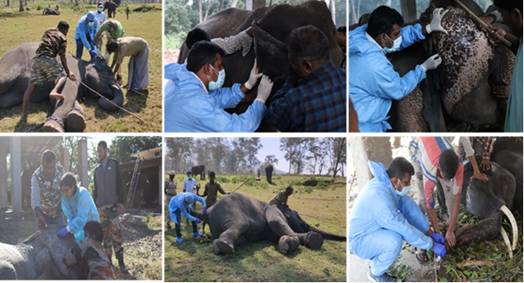Ministry of Science & Technology
Study of virus causing hemorrhagic disease in elephants might help in the development of diagnostics & therapeutics.
Posted On:
06 DEC 2023 5:34PM by PIB Delhi
Probing the haemorrhagic disease (HD) among Asian elephant population a new study assessed the circulation of the elephant endotheliotropic herpesvirus subtypes (EEHV) responsible for the recent rise in the disease, as well as its pathogenesis. The research on the patho-epiemiology or the study of the determinants, occurrence, and distribution of the disease can help develop sero-diagnostics, vaccines and therapeutics against the disease.
The increased mortality of elephant calves due to haemorrhagic disease noticed in captivity as well as in free range in India is a cause of concern. Asian elephants are National heritage animals of our country and accounting 55% of total world elephant population. This population has been decreasing due to increasing outbreak of EEHV-HD. So, it is important to protect them from the lethal disease. Like other herpesviruses, EEHVs seem to have successfully co-evolved with their hosts and established a well-balanced adaptation. Several scientific studies in recent years have significantly advanced our knowledge on the molecular identification and characterisation of different EEHV strains but not in India except few case reports. More intensive screening is needed to establish the status of the disease in the wild as well as in captive populations. A holistic approach will be required to create a point of care diagnostics to confirm the lethal virus at the pre-clinical stage.
The study by ICAR-Indian Veterinary Research Institute (ICAR-IVRI), Izatnagar, Bareilly, supported by Science and Engineering Research Board (SERB), an attached institution of Department of Science and Technology, has found the exact status of EEHV and its subtypes circulating among Asian elephant population in India. The research published in the journal Microbial Pathogenesis characterized the genome of the virus circulating in Indian elephant population and traced the molecular mechanism of dysfunction of endothelial cells associated with this disease. Work has been initiated to facilitate developing diagnostic kits (Pen side) and vaccines based on this work.
The information gathered from this project's research helped to create SOPs that handle disease information among mahouts and elephant conservationists.
Publication link:
https://www.sciencedirect.com/science/article/abs/pii/S0882401023000050?via%3Dihub

***
SNC/PK
(Release ID: 1983198)
Visitor Counter : 1416